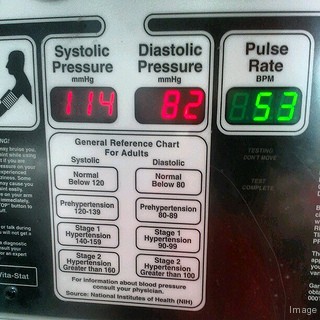Ideal blood pressure refers to the BP level at which you are at lowest risk for BP related health problems. Although the measure varies a little between women and men and also varies by age to some extent, in general a blood pressure reading between 100 over 65 and 130 over 85 are considered to be within the healthy range. Ideal blood pressure is 120/80.
The two numbers in blood pressure readings refer to the systolic and diastolic pressure readings. The higher number is the systolic pressure or pressure on your veins while your heart is beating. The lower number, diastolic reading refers to the measure pressure while your heart is at rest, or between beats.
Any reading under 100 over 65 is considered low blood pressure. Although LBP doesn’t carry as many health risks as high blood pressure, it is important not to ignore it. Hypotension, the technical term for LBP, can lead to dizziness, weakness, fatigue and fainting.
Although none of these are fatal symptoms if combined with certain activities, like driving to work or school, the consequences could be fatal. LBP has many possible causes, sun stroke, dehydration, blood loss through trauma and some forms of heart disease can all lead to hypotension. Treatment is contingent on the underlying cause, or in some cases medication can be used to raise BP.
High Blood Pressure, on the other hand, is a killer. Even a slight elevation above normal blood pressure cans double your risk of stroke and cardiac arrest. About 95% of patients suffering from hypertension have no known underlying condition that is resulting in the elevated pressure. This is known as primary hypertension, and is treated with medication and restrictive diets.
If you are suffering from hypertension, or have borderline HBP, there are many steps you can take to help your body relax and reduce your BP, as a result. Regular exercise is important to maintaining healthy blood pressure levels and relaxing routines such as yoga and Pilates can have been shown to significantly lower your BP by lowering stress levels and improving circulation.
Modifying your diet is another important part of maintaining or achieving ideal blood pressure levels. Stay away from red meat that is high in cholesterol as well as salt and salty foods & replacing them with fish, chicken and lots of fresh foods and vegetables is important and proven to actively reduce BP levels.
Another aspect of modifying your diet is selecting foods that are known to lower or normalize your blood pressure. Buy extra virgin olive oil instead of regular vegetable oil, dark chocolate and drink green tea. Swapping out some of the common ingredients in your meals for pressure friendly ones, is a great way to help normalize your BP.
Finally, it’s important to check your blood pressure on a regular basis. Many pharmacies and drug stores provide free pressure cuffs for free readings. By checking your progress, and making sure your pressure is the ideal blood pressure you can help maintain your health and lower your risk of developing BP related problems.
